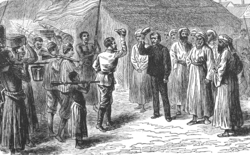Henry Morton Stanley
Sir Henry Morton Stanley GCB (born John Rowlands; 28 January 1841 – 10 May 1904) was a Welsh journalist and explorer. He was famous for his exploration of central Africa, and his search for missionary and explorer David Livingstone.
Sir Henry Morton Stanley | |
|---|---|
 Journalist and explorer | |
| Born | John Rowlands 28 January 1841 |
| Died | 10 May 1904 (aged 63) |
| Awards | Vega Medal (1883) |
| Signature | |
When he found Livingstone, Stanley reportedly asked, "Dr. Livingstone, I presume?" Stanley is also known for his search for the source of the Nile, his work in the Congo Basin, and for commanding the Emin Pasha Relief Expedition.
Stanley's expeditions are known for the cruelty and murders of Africans. He has the highest kill rate among Africa's explorers.[1] Despite this, he was highly admired and supported by British and Belgian monarchies and knighted in 1899.
Stanley was MP for Lambeth North from 1895-1900.
Early life
Stanley never knew his father, and was abandoned by his mother after birth. His birth certificate describes him as John Rowlands, a bastard. The stigma of illegitimacy weighed heavily upon him all his life.[2]
In New Orleans he renamed himself as Henry Morgan Stanley, joined the Confederate States Army and was captured. He joined the Union Army and later the Union Navy.
Finding Livingstone
In 1869, Stanley was instructed by the New York Herald to find the Scottish missionary and explorer David Livingstone, who was known to be in Africa but had not been heard from for some time. According to Stanley's account, he asked how much he could spend. The reply was "Draw £1,000 now, and when you have gone through that, draw another £1,000, and when that is spent, draw another £1,000, and when you have finished that, draw another £1,000, and so on — BUT FIND LIVINGSTONE!" Stanley had lobbied his employer for several years to mount this expedition.
Stanley found Livingstone on 10 November 1871, in Ujiji near Lake Tanganyika in present-day Tanzania. He may have greeted him with the now-famous line, "Doctor Livingstone, I presume?" It may also have been a fabrication, as Stanley tore out of his diary the pages relating to the encounter.[2]
Researching the Congo River
In 1874, the New York Herald, in partnership with Britain's Daily Telegraph, financed Stanley on another expedition to the African continent. One of his missions was to solve a last great mystery of Africa by tracing the course of the Congo River to the sea. The difficulty of this expedition is hard to overstate. Stanley used sectional boats to pass the great cataracts that separated the Congo into distinct tracts. The boats had to be taken apart and transported around the rapids before being rebuilt to travel on the next section of river. After 999 days, on 9 August 1877, Stanley reached the Portuguese outpost of Boma, around 100 km from the mouth of the Congo River. Starting with 356 people, he reached Boma with 114 survivors, and he was the only European left. He wrote about his trials in his book Through the Dark Continent.[3]
Claiming the Congo for the Belgian king
Stanley was approached by King Leopold II of the Belgians, the ambitious Belgian monarch. In 1876 the king organized a private holding company disguised as an international scientific and philanthropic (goodwill) association. He called it the International African Association.
The King spoke of his intentions to introduce Western civilization and bring religion to that part of Africa. He did not mention he wanted to claim the lands. At the end of his life, the King was embittered that his establishment of a Congo Free State was spoilt by its unscrupulous government. Also, the spread of sleeping sickness across central Africa may have been caused by the movements of Stanley's enormous baggage train,[4] and the Emin Pasha relief expedition.
Emin Pasha Relief Expedition
In 1886, Stanley led the Emin Pasha Relief Expedition to "rescue" Emin Pasha, the governor of Equatoria in the southern Sudan. King Leopold II demanded that Stanley take the longer route, via the Congo River. He hoped to get more territory. After immense hardships and great loss of life, Stanley met Emin in 1888, charted the Ruwenzori Range and Lake Edward, and emerged from the interior with Emin and his surviving followers at the end of 1890.
This expedition tarnished Stanley's name because of the conduct of the other Europeans: British gentlemen and army officers. An army major was shot by a carrier, after he behaved with extreme cruelty. James Sligo Jameson, heir to Jameson's, an Irish whiskey manufacturer, bought an 11-year-old girl and offered her to cannibals to document and sketch how she was cooked and eaten. Stanley found out only when Jameson had died of fever.[2]
Henry Morton Stanley Media
Stanley's graffito at Persepolis, Iran
The contract signed between Henry Morton Stanley and Tippu Tip on behalf of King Leopold II at the British consulate in Zanzibar in 1887, in which Leopold appoints Tippu Tip as governor of the Stanley Falls District
Stanley receives the Freedom of the City of London in 1890.
References
- ↑ Hochschild, Adam 1998. King Leopold's Ghost: a story of greed, terror, and heroism in colonial Africa. New York: Houghton Mifflin. ISBN 0-618-00190-5
- ↑ 2.0 2.1 2.2 Jeal, Tim 2007. Stanley – the impossible life of Africa's greatest explorer. London: Faber and Faber. ISBN 0-571-22102-5
- ↑ Stanley, Henry M. (1988). Through the Dark Continent. Dover Publications. pp. 432 pages. ISBN 0-486-25667-7.
- ↑ Alastair Compston (2008). "Editorial". Brain. 131 (5): 1163–64. doi:10.1093/brain/awn070. PMID 18450785.









